 D&D Essentials have arrived and yesterday I received my copy of the Rules Compendium and Heroes of the Fallen Lands. I have to admit that at first I had no intention of picking up any books in the Essentials line. I figured I would wait for Character Builder to update and then look at the new options that are available. I’m glad I didn’t.
D&D Essentials have arrived and yesterday I received my copy of the Rules Compendium and Heroes of the Fallen Lands. I have to admit that at first I had no intention of picking up any books in the Essentials line. I figured I would wait for Character Builder to update and then look at the new options that are available. I’m glad I didn’t.
For those not aware D&D Essentials is an alternate path for advancement available to your D&D characters. The Essentials line is a series of 10 products that gaming shops are encouraged to keep in stock. They are essentially the new entry point for beginner players. That being said, players other than beginners may find the new options to their liking. For more information on the Essentials line, including release dates, read our post regarding the Wizards of the Coast Preview.
There has certainly been a lot of debate about the merit of the Essentials line and it’s place in 4e D&D. I’m not here to tell you Essentials is the best thing since sliced bread or that it’s the worst product WotC has produced in years. Instead I’ll give you my honest feedback of what I’ve read so far and leave you to make your own decisions.
My biggest complaint with 4e is the lack of fluff. The PHB told me how to make a character, but I really felt it lacked the depth of material required for me to become immersed in the new edition. I’m fortunate that my home group plays in the Eberron campaign setting, so we already have a detailed world to become immersed in. If you are a new D&D player and you don’t have this resource to draw on, it could leave the initial release of 4e feeling hollow with a lot of information to absorb.
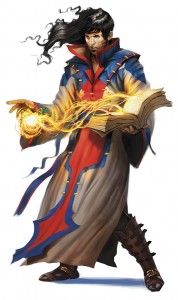 When I say a lot of information to absorb I mean the Player’s Handbook has 122 pages devoted to characters, more specifically powers. Only two pages per class were devoted to fluff. With 8 classes represented in the PHB1, that’s 16 pages of fluff and 106 pages of powers. If you pull out your PHB for 3.5 you’ll find 38 pages devoted to character classes in that book. Clearly, there was a large shift in how classes and the entire mechanics of 4e work. Now don’t get me wrong, I love 4e and can’t imagine going back and playing any of the previous editions. But it’s taken the release of the Essentials line to really hammer home what I don’t like about 4e. As much as I may enjoy the current edition, I’m not so naive as to think it’s perfect.
When I say a lot of information to absorb I mean the Player’s Handbook has 122 pages devoted to characters, more specifically powers. Only two pages per class were devoted to fluff. With 8 classes represented in the PHB1, that’s 16 pages of fluff and 106 pages of powers. If you pull out your PHB for 3.5 you’ll find 38 pages devoted to character classes in that book. Clearly, there was a large shift in how classes and the entire mechanics of 4e work. Now don’t get me wrong, I love 4e and can’t imagine going back and playing any of the previous editions. But it’s taken the release of the Essentials line to really hammer home what I don’t like about 4e. As much as I may enjoy the current edition, I’m not so naive as to think it’s perfect.
The Essentials line attempts to bridge the gap. On my first read through Heroes of the Fallen Lands my initial thought was that this book should have been released first. It should be the Player’s Handbook.
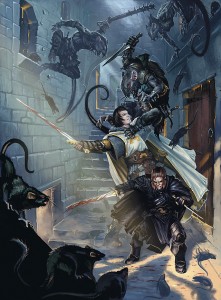 My reasons for purchasing Heroes of the Fallen Lands was the promise made during the WotC preview seminar at GenCon this year, that we would see more fluff and background material in the source books. I wanted to see if the release of this first Essentials product would deliver on that promise. I’m pleased to say that it does, though not as much as I had hoped. I’ll temper that comment with the revelation that I love background source material. This material is often some of the best material released as they fill the heads of DMs and players alike with ideas.
My reasons for purchasing Heroes of the Fallen Lands was the promise made during the WotC preview seminar at GenCon this year, that we would see more fluff and background material in the source books. I wanted to see if the release of this first Essentials product would deliver on that promise. I’m pleased to say that it does, though not as much as I had hoped. I’ll temper that comment with the revelation that I love background source material. This material is often some of the best material released as they fill the heads of DMs and players alike with ideas.
The books in the Essentials lineup were released in digest format and I must say I’m a fan. If I have one complaint about digest format it’s that I like to put my character sheet on my book and role dice on it. We all have our habits and this is one of mine. From a weight perspective the books are comparable to the PHB. The quality of the paper and binding is good, this is not a flimsy book and production values appear high. Heroes of the Fallen Lands comes in at 345 pages and the Rules Compendium contains 319 pages. I didn’t know there were that many rules either.
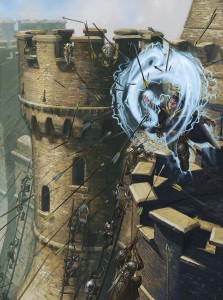 The cover and chapter art of the books are great, serving to suitably inspire all players with new ideas. Chapter art in the Heroes of the Fallen Lands contain a caption explaining the scene, presumably to assist new players in understanding the creatures and actions that are available. The interior art is also fantastic, many of the contributing artists are individuals whose names you’ve seen and heard before. Unfortunately, so are many of the images. Much of the art was released in earlier 4e products and has been recycled in in these first two Essentials products. I’m fairly disappointed by this, as I said the work is top notch, but if WotC is going to release a new product new art would also be nice. Especially if they want the existing player base to buy the product. My final comment on the art is that there isn’t enough of it. I’m not sure if this is because the book is in digest format, and therefore words and art are spread out further than a regular publication, but the book could use more art on the pages. Even another half dozen images would do wonders to making the book feel fuller and more vibrant.
The cover and chapter art of the books are great, serving to suitably inspire all players with new ideas. Chapter art in the Heroes of the Fallen Lands contain a caption explaining the scene, presumably to assist new players in understanding the creatures and actions that are available. The interior art is also fantastic, many of the contributing artists are individuals whose names you’ve seen and heard before. Unfortunately, so are many of the images. Much of the art was released in earlier 4e products and has been recycled in in these first two Essentials products. I’m fairly disappointed by this, as I said the work is top notch, but if WotC is going to release a new product new art would also be nice. Especially if they want the existing player base to buy the product. My final comment on the art is that there isn’t enough of it. I’m not sure if this is because the book is in digest format, and therefore words and art are spread out further than a regular publication, but the book could use more art on the pages. Even another half dozen images would do wonders to making the book feel fuller and more vibrant.
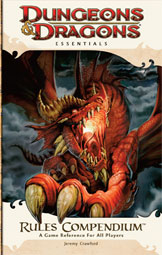 Rules Compendium
Rules Compendium
I’m not going to label this a must buy. If you have a DDI subscription and a laptop open during your game sessions you have access to everything in the Rules Compendium, making this purchase redundant. I am going to label it a should own, the folks at WotC have done a great job of collecting all the rules and dropping them into one books.
The contents are organized in a structured way that makes sense and is easy to navigate. It also takes information contained over multiple sources, pares it down and combines it into one entry. Very helpful. A few weeks ago my group was looking up rules on disease and were bouncing between the DMG and MM. No longer, it’s all in one location. Some rules that didn’t seem clear before appear to have received clarification. Recently we wrote an article regarding rule clarifications on teleportation. Had the Rules Compendium existed when we wrote the article, well we wouldn’t have needed to write the article.
One of my favourite features of the Rules Compendium is the glossary. Every term and condition is briefly described at the back of the book. On its own this is a great resource, combined with the rest of the book it does make the Rules Compendium a great book to have on any gaming table.
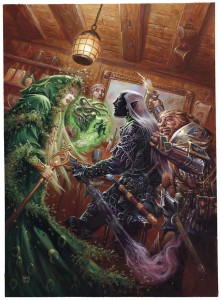 Skill challenges, always a favourite subject here, have also received some attention. The new skill check DCs are included along with some new mechanics for larger skill challenges. There is information on skill challenge complexity, that is how many moderate and hard checks should be in a given challenge. A clear definition between primary and secondary skills in skill challenges is also present. Finally, a new mechanic called Advantages has been introduced for skill challenges that have a complexity level higher than three. The idea behind this mechanic is to provide the adventurers a way of gaining an advantage. Examples include awarding two successes for defeating a hard DC check. We and other bloggers have written a lot on skill challenges as they are a new and perhaps misunderstood element of the game. The section on skill challenges in the Rules Compendium helps to broaden the amount of official advice available from WotC. This section is well worth the read.
Skill challenges, always a favourite subject here, have also received some attention. The new skill check DCs are included along with some new mechanics for larger skill challenges. There is information on skill challenge complexity, that is how many moderate and hard checks should be in a given challenge. A clear definition between primary and secondary skills in skill challenges is also present. Finally, a new mechanic called Advantages has been introduced for skill challenges that have a complexity level higher than three. The idea behind this mechanic is to provide the adventurers a way of gaining an advantage. Examples include awarding two successes for defeating a hard DC check. We and other bloggers have written a lot on skill challenges as they are a new and perhaps misunderstood element of the game. The section on skill challenges in the Rules Compendium helps to broaden the amount of official advice available from WotC. This section is well worth the read.
 Heroes of the Fallen Lands
Heroes of the Fallen Lands
I felt like I was a kid again as I flipped through this book. The layout reminded me of opening Player’s Handbooks of editions gone by. Heroes of the Fallen Lands will tell you how to build a character from the ground up. If you purchase this book, you don’t need the PHB to fill in the rest of the rules. Everything is here from character creation, equipment and combat.
Heroes of the Fallen Lands details Clerics, Fighters, Rogues and Wizards, the core classes that belong in D&D and it does a good job of it. There is a great deal more fluff about playing the class. Read this as new-player friendly, if you’ve been playing D&D for years or any computer RPG then you really know what these classes do. What Heroes of the Fallen Lands does it help place the classes into the lore of Dungeons & Dragons.
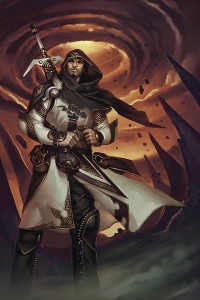 The Essentials builds of these four iconic classes are different from the original release of 4e. However, much is still very familiar. While I haven’t built a character yet, the power level does seem to be on par with what is available in the PHB. While the Essentials version of the classes isn’t necessarily simpler, I do feel that they are what should have been released with the launch of 4e. The classes really feel like a hybrid of Original Red Box, AD&D 2e, 3.5e and 4e mixed together together in a cauldron with the end result being a very tasty concoction. For sure they aren’t for everyone, but they are worth looking at.
The Essentials builds of these four iconic classes are different from the original release of 4e. However, much is still very familiar. While I haven’t built a character yet, the power level does seem to be on par with what is available in the PHB. While the Essentials version of the classes isn’t necessarily simpler, I do feel that they are what should have been released with the launch of 4e. The classes really feel like a hybrid of Original Red Box, AD&D 2e, 3.5e and 4e mixed together together in a cauldron with the end result being a very tasty concoction. For sure they aren’t for everyone, but they are worth looking at.
One of the big complaints that I’ve read is that the Essentials builds won’t be compatible with the existing 4e classes. Nothing could be further from the truth.
“Other Dungeons & Dragons supplements, including Dungeons & Dragons Insider, offer additional powers that you can choose from. Whenever you choose a new class power, you can select it from the list presented in this book or you can take a power of the same class, level and type (attack or utility) from another source.
For example, when your slayer reaches 2nd level, you could select a 2nd-level fighter utility power from a source other than this book or you could choose one of the 2nd-level fighter utility powers in the “Knight” section of this book.” – page 52, Heroes of the Fallen Lands.
What this provides is very easy power customization. Many of the options available to Essentials characters are very appealing. I play an Assassin in our home game and I’ll be reviewing the Essential Assassin released through the DDI (subscription required) to see if any of the options present there will work for my character. Yes, DDI members you get a bonus Essential class to play with. Think of it a test, if you like what you see you will probably enjoy the Essential builds.
 The classes felt right to me. The Wizard felt like a Wizard should, an individual casting spells memorized from a book. Not an individual using a power, called a spell, like every other character. Fighters give up daily powers in favour of more at-will powers, representing stances. The stances vary from aggressive, to defensive, to everything in-between. From a flavour perspective it make sense and actually looks like a fun class to play. Based on the limited experience I had playing the Fighter during the Convention Delve at GenCon, the fighter should be fun to play.
The classes felt right to me. The Wizard felt like a Wizard should, an individual casting spells memorized from a book. Not an individual using a power, called a spell, like every other character. Fighters give up daily powers in favour of more at-will powers, representing stances. The stances vary from aggressive, to defensive, to everything in-between. From a flavour perspective it make sense and actually looks like a fun class to play. Based on the limited experience I had playing the Fighter during the Convention Delve at GenCon, the fighter should be fun to play.
While Heroes of the Fallen Lands details four classes it contains five builds. The Fighter is able to pick between the role of defender or striker. My thought on this was finally, as it’s something we wrote on well over a year ago in our article the Fighter as a Striker. It is also interesting to note that the two fighter builds receive different armour proficiencies. The Knight starts off with plate and shield proficiencies, the Slayer only receives training up to scale and has no training with shields. Both receive the same starting hit points and hit point progression. While both builds are Fighters, the Slayer does not receive the new Aura Mark or any other power that can mark an enemy. This demonstrates how WotC is playing with the role system and producing two builds that both feel like fighters. The Slayer might not be able to mark, but his other abilities make it so no enemy on the field will want to ignore him. With the release of Heroes of Forgotten Kingdoms in November we will have our first martial controller represented in a Ranger build. This makes me wonder what similarities it may have with the Seeker.
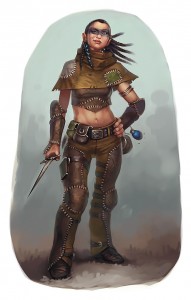 The section on races does contain a little bit more background on how the race fits into the lore of D&D. Don’t look for 100% new material here though. Much of the content of the Dwarf, the only race I read in great detail (they are the best race), is pulled from the PHB. While disappointing, it’s not surprising. WotC wasn’t out to rewrite the lore on the races, just provide more information on where they fit in.
The section on races does contain a little bit more background on how the race fits into the lore of D&D. Don’t look for 100% new material here though. Much of the content of the Dwarf, the only race I read in great detail (they are the best race), is pulled from the PHB. While disappointing, it’s not surprising. WotC wasn’t out to rewrite the lore on the races, just provide more information on where they fit in.
The feat section contains both new and old feats. Most of the new feats are themed around the deities and all start with Disciple of… Again the point of the release was not to provide 100% new content, but for an easy launching point for new players. As a result some of the most common feats are repeated.
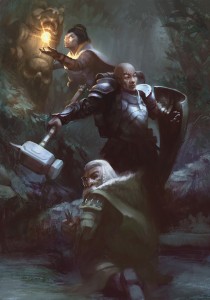 Both the Rules Compendium and Heroes of the Fallen Lands are good releases. If you’ve been playing 4e since release you don’t need these books. However, if you are new to D&D (not just 4e, but D&D as a hobby) I will say that they are Essential. These releases are a better entry point into D&D than the original 4e core books. A copy of the Rules Compendium on your groups table would be a wise investment, but not necessary. If you are interested in seeing how WotC have again stretched the mechanics of 4e to create something new, yet compatible, pick up Heroes of the Fallen Lands.
Both the Rules Compendium and Heroes of the Fallen Lands are good releases. If you’ve been playing 4e since release you don’t need these books. However, if you are new to D&D (not just 4e, but D&D as a hobby) I will say that they are Essential. These releases are a better entry point into D&D than the original 4e core books. A copy of the Rules Compendium on your groups table would be a wise investment, but not necessary. If you are interested in seeing how WotC have again stretched the mechanics of 4e to create something new, yet compatible, pick up Heroes of the Fallen Lands.
Much of the debate and anger towards the Essentials release is the perception that they are D&D 4.5e. After reading them, I can say I don’t feel that they are. In many ways the Essentials release is superior to what we already have, but they aren’t a new edition. I would also wager that a group using characters built from the Essentials rules over a group using characters from existing sources will finish an encounter quicker. This is because the options have been pared down. In the case of the Fighter you aren’t debating what power to use, you know what power you’re going to use. You are going to swing your sword, everything else is window dressing.
If you’ve read this far it’s apparent that I’m a fan of what I’ve read in Heroes of the Fallen Lands. Other than the Convention Delve at GenCon I haven’t seen any of the new Essentials builds in action. The current season of Encounters should give both experienced and new players alike a better sense how good or bad these builds are.
Have you picked up any of the new Essentials products? How do you feel they measure up compared to other D&D 4e releases?
 Looking for instant updates? Subscribe to the Dungeon’s Master feed!
Looking for instant updates? Subscribe to the Dungeon’s Master feed!
21 replies on “The Essentials On D&D Essentials”
I know you are upset that a lot of the art is reused but it is one of the most expensive parts of the production. I had no desire to buy these books because the info would be in character builder, eventho I love to have real paper to flip through. (There are so many good things in this hobby to spend your money on. Back to my point.) The price point on these books are absolutely perfect for new players and even skeptics would pick them up. I am going to get them for my collection.
i like the rules compendium but as for the new classes, i think you said it best here
‘… the options have been pared down. In the case of the Fighter you aren’t debating what power to use, you know what power you’re going to use. You are going to swing your sword, everything else is window dressing.’
thats exactly why i hate it in a nutshell
@ Ragnarok
I have no doubt the art is one of most expensive elements, it needs to be or we will loose the hugh quality art we are accustomed too. I agree that the price point is perfect.
@ J
This is what I like best about the new fighter builds. The stances make more sense to me and still provide plenty of options.
I agree with you, that if Essentials were the first 4e release instead of the existing PHB, the transition from 3.5 would have been smoother and would have ruffled fewer feathers. While I wouldn’t want to play a lot of these builds – like the Slayer or Warpriest – I’m very happy they *exist*. I don’t expect everything in 4e to be to my tastes; I’m thrilled that the 4e tent is expanding, and that my players of varying skill levels can choose easier or harder classes to play.
My Dark Sun game, which started last week, has almost a 50-50 mix of Standard and Essentials classes. It went smoothly and seamlessly; there’s no issue or confusion with mixing and matching the two.
I do think the Mage is a power-up, relative to the original Wizard, but at the same time, I think it needed it. I much prefer the school specialization to implement mastery. Although, I have to note, the party’s tiefling enchanter completely destroyed my entire field with Beguiling Strands and an action point. Bye-bye, 10 minions! See you later, wasteland raiders! That’s the new champion of the Wizard At-Wills, IMO.
I’m surprised you didn’t spend more time on the feats. If anything will affect existing 4e games, it’s these. They’re generally more potent, available earlier, and just plain cooler than the originals. 2/3 of my players picked one up. I’m also pretty pleased that Weapon Focus and Implement Focus have been segregated, although I wish they provided a band-aid for weapliment users like the Swordmage.
While I agree with a lot said in this article I feel I have to disagree with the “the classes feel as they should”, at least in terms of fun. While the Warpriest and the Mage stick to the ‘traditional’ 4e system of powers (more or less), the Martial characters lose out on daily and encounter /attack/ powers, instead getting stances (fighter) or tricks (rogue). I like the Rogue’s tricks – basically alternate move actions that grant them new ways of getting combat advantage for their basic attack power.
The Fighter’s stances are equally interesting, if not appealing to me personally – they’re minor actions that add effects to basic attacks, like turning all basic attacks into ‘cleave’.
My beef is with the fact that over a Fighter’s career (level 1-30) they never get to choose from any more than the original 6 stances they could choose from at level one. They gain utility powers like any other class (and they’re cool utilities) and some neat class features, but they never grow out of this limited pool of stances.
Another feature of the new Fighter builds is the ‘power strike’ encounter power, which basically lets the Fighter add 1[W] to any attack they make that hits. As they level they gain additional uses of this power.
These features add a degree of flexibility to the Fighter – they can adjust their basic attacks to do /exactly/ what they want through stances, etc. but I feel it could have been developed further.
To conclude – everything in Essentials feels balanced with other 4e products, but the martial characters seem to get a (very slightly) shorter end of the stick.
@ obryn
I had originally intended to write more on feats, but as the article started pushing 2500 words I decided to keep this section brief. To be sure there are some interesting new feats. Cold & heat adaptation are going to start appearing on a lot of character sheets over the next few weeks. I’m actually working on an article on feats in general and the new options in the Essentials line will be discussed there.
@ Phillip J. King
I’ll agree that it seems the martial characters get the short end with Essentials in terms of options. It appears as though the designers were attempting to line up class balance the way it appeared on older editions, where Wizards had all sorts of spells and Fighters just swung their sword. While the Essentials builds aren’t that draconian, they do have that feel.
I bought the Red Box because, well, just because.
I also picked up the Compendium and HotFL. I have to say, I’m pretty pleased. I played on D&D game day a couple of weeks ago as a Slayer pregen and absolutely loved it. The stances work really well. I love the idea that with the use of a minor action, you can basically go into “hit” mode, “damage” mode or “defense” mode, while still being a major threat on the battlefield. This is exactly as a fighter should be IMO. Thats what I took you to mean when you say “the fighter feels right”. I totally agree. Don’t get me wrong, I enjoy the original incarnation of the fighter, but applying the 4E power system to the fighter class always seemed like a bit of a stretch, an effort to fit every class into the same power curve even though it didn’t make thematic sense to do so. Now I feel like they’ve fixed it. The other thing was that fighters we squeezed into the defender role. For some fighter builds, that makes sense, but also IMO, fighters should be massive damage dealers as well. To not have amazing striker built fighters in 4E seemed an oversight at best, a massive design flaw at worst. I realize there are some high damage capabilities of the 4E fighter. I get it. I just like the idea of the classes being balanced, without being homogenized and with Essentials builds, thats exactly what we get.
I don’t see boredom as a real issue with any of these new builds. Mostly, because if you don’t like them, you shouldn’t play them.
Having said all that, I would like to make a quick comment on all the internet rage of the Essentials products. I find it simply astounding, and, quite frankly, embarrassing for the hobby. I’ve been following a now 600+ comment thread on the wizards forums. It’s completely out of control. Some are saying Essentials literally “ruins” D&D. Others like myself like the options presented. I just don’t understand internet rage and where it comes from. If you don’t like the new options, you can simply ignore them. 4E is a very robust system and can easily handle these types of mechanical expansions. I think wizards has done a great job building a base system for which expansion can happen without breaking anything.
Essentials has me very much excited for 4e right now, much more than when it first came out.
After PHB3, I sort of tuned out a bit. I felt all those classes and races that were introduced weren’t my cup of tea, but with Essentials I’m getting a vibe of “this should have been the presentation from the beginning”.
Right now my plan is to run an all Essentials game in the near future, so we’ll see what happens. 🙂
I’ll agree with newbie.
I’d like to add one thing that excites me about essentials I forgot to mention.
One of my main gripes about 4E was that the way the powers were designed, it was nearly impossible to run combat with a grid and minis/tokens. With the new simplified/iconic Essentials builds, I think it may again be possible to make battlegrids/dungeon tiles optional. I like to have the tactial options of tiles and minis, but I don’t like that it’s pretty much mandatory with most 4E powers in effect. I can forsee a future where basic and random encounters are run the old way, with no minis or grids and then for the big set piece battles, you roll out the battle mat and go to town. Combat on the mat just takes too long, even to resolve smaller battles. If your group is heavily into tactics, this is probably not a problem but when you run a heavily RP game that is only punctuated by thematic conflicts, the battle mat/minis can be somewhat jarring of a transition.
Short version: I’m an oldschool 1E kind of guy and I’d like to run combats as RP based on mechanics, rather than tactical combats.
@ mbeacom
I’m a big fan of the stances fighters receive and I’m looking forward to an opportunity to test them out in the future.
@ NEWBIEDM
I agree 100%, the Essentials products are what 4e should have been at release.
As mentioned a few times, Essentials would have made a fantastic transition piece, but now that I have been playing and DMing 4th for some time, it feels limiting, Philip’s mention of the fighter is a prime example. Even with limitations, it does what it was meant to do, simplify and ease new people into 4th.
Some of the changes I like include the fighter having an aura instead of marking an individual monster is fantastic and a change I am making for every fighter, not just the essentials. I also like the stances, great flavor and quite frankly, they just make sense.
A friend mentioned Magic Missile had errata prior to the release of Fallen Lands so it would be auto hit, but regardless, I think this is a welcome addition. Though between magic missile and beguiling strands, level 1 wizards are the ultimate minion killers. In Halistar’s Apprentice (Encounters Season 1), not a single person earned the achievement for killing three minions in one hit. The two wizards accomplished this feat in the first session of Keep on the Borderlands.
I can say from experience that Essentials runs just fine with standard PHB characters, so I am not sure where that argument is coming from. Fallen Lands isn’t my favorite book or update, but I wouldn’t even think of saying it ruins 4th Edition, it just gives different options. It would be interesting if they released it as PHB4 if people would still go batty over the changes.
Really, my biggest complaint with the Essentials line is Wizards hasn’t update the character builder to include Essentials as promised.
I always get angry when you refer to background info as ‘fluff’. I find that very derogatory. In my opinion, the stuff you call fluff is the reason I play role-playing games. I don’t give a damn about the dice mechanics: I want the escapism. Please don’t condescend.
My apologies if I’m speaking out of turn but…..
Strange that you would get angry about Wimwick referring to fluff, when he mentioned repeatedly that he wanted MORE of it, not less. He clearly considers it good an desirable.
I agree, calling something “fluff” makes it sound insignificant or unimportant but based on the context of the article thats clearly not what is meant.
I think it’s pretty clear the industry has settled on 2 terms, “fluff” and “crunch” to designate the 2 mainstays of RPGs, the background info and the mechanics.
I was listening to a podcast recently with Ed Greenwood and he also mentioned that he doesn’t like the terms “fluff” and “crunch”. He said he prefers, “story” and “rules” which is probably a better way to put it, but it is what is.
Personally I LOVE the fluff. The crunch just tells us how to interact with the fluff. 🙂
@ Kirk
Three things, first I love fluff. Second, while I don’t mean to condescend, I also don’t worry about offendinging. Finally, if memory serves fluff was how it was referred to at the WotC seminar. Maybe not the best term, but you did know what I was referring to.
I’ve just bought some Essencials books. My first impression was good but one point I’ve already noted is that I saw a lot of “repeated” information on all those books. I mean, all of them has the same introductory “what is rpg”, “how to play” and other rules stuff… I know that’s good for begginers and so but I don’t think it’s cool to have so much repeated material through all the books.
Did D&DE do away with Core though are they being produced still? PHB4e=$35 and you got the whole game from a player perspective. Essentials=$80+ to get the same thing you get for $35 in the PHB. It looks like another splat book money scheme that WoTC is famous for it seems to me.
Actually, quite the opposite. You only need to spend $19 for one of the Essentials player books and you have the whole game from a player perspective.Essentials made entry into the hobby quite a bit cheaper. With the DM kit, the DM can buy all the rules and a couple of really good adventures plus all the maps and tokens he needs to run them for about the same price as the DMG. The monster vault is another amazing product.
hmm thanks but the math doesn’t compute. I was flipping through the essentials books this weekend at a store and one would need the 3 class essentials plus the Rules compendium to be equivalent to the PHB. Of course the Essentials has more of what I call splat classes in it though. So that is $20×4=$80.
My concern is if D&D-E is the new product. Have they done away, ceased publishing the core ones? It’s confusing.
thanks ahead of time for your clarifications.
sincerely,
Rob
That’s incorrect. There are only two class Essentials books, not three. And you don’t need both. To play, you need only the PHB or EITHER Heroes book. You don’t need both. Which one you buy will simply determine which selection of classes you get. The first heroes book has the core classes/races, plus a few more, much like the PHB (the class/race list is not identical, they’ve removed some and added others) . The second heroes book has an expanded list of classes and races, some from PHB and some from PHB2 and some altogether new ones. So your math is based on incorrect info. And the compendium is just a rules reference, one that you would only really NEED if you buy the original PHB because the PHB has out of date rules, but one that you will NOT need if you buy one of the heroes books because the information will be the same between them.
Short Version:
The only thing a player NEEDS to get started is a single Heroes book ($19) or the PHB and Rules Compendium ($55). Nothing else.
The only thing a DM NEEDS is the DM Kit. Which is also the big money saver because if you buy the DMG, you’ll still need to buy tokens, maps, minis, or whatever to represent the combats separately. Whereas the DM kits comes with all that for the first 4 or so levels which is a couple of months of play.
Ok I see, so the second Hero’s book is the “splat” classes/PHB2 kind of stuff and the rules are still in the Hero’s book like they are in the PHB. It appeared to me that these essential books were just kind of like ripping out the race and class sections from the PHB is all.
The DM kit I find to be a matter of opinion and generational gap difference though. I’m old school and have never found a “need” for maps, minis, counters etc… but to each his own for that stuff.
thanks for the clarifications.
It does appear though that they have abandoned the core books and the game is now D&D-E. News they released today of course is that even that is dodo bird now as 5th edition is now in full swing. This crap is why I still have always stuck to nothing more than PHB/DMG/and MM from WoTC products.
thanks for your clarifications and info take care,
Rob
Holy Cow! Yeah, worldshaking news today. One note though, I’m old school too and prefer to run without a combat map, but 4E rules are such that it is required. More so than any previous edition. I’ve tried to run 4E combat without a grid/map/minis and its pretty much impossible. Thats why the DM Kit is such a life saver. Nice talking to you. Hope you have fun in whatever you decide, either option is truly viable.